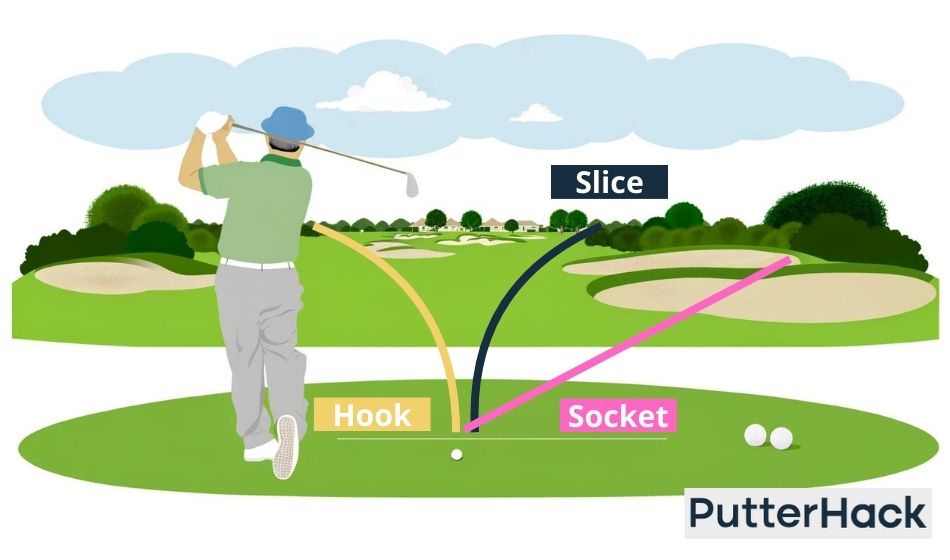
Identify Problems in Your Swing: SLICE, HOOK, and SOCKET
17 de February de 2024
Do you feel like your golf game isn’t up to par? Often, the most frustrating problems on the course come from inconsistent shots. But don’t worry, you’re about to discover how to identify and correct the most common mistakes: the slice, the hook, and the dreaded socket or hosel hit.
These failures not only affect your score but also your confidence. Fortunately, with a little technical knowledge and practice, you’ll be back on the path to success. Let’s break down each of these problems and give you practical solutions so you can enjoy a clean and precise swing.
So, if you’re ready to say goodbye to those wayward shots and improve your game, you’re in the right place. Keep reading and get ready to transform those mistakes into hits with effective tips that you can apply today on the golf course.
Swing Error Diagnosis
Identifying problems in your golf swing can be frustrating. But don’t worry, we’re here to help you diagnose those common errors like the slice, the hook, and the socket. With a little attention and practice, you can correct them and improve your game.
The slice is one of the most common errors and is characterized by a ball flight that curves dramatically from left to right (for a right-handed player). This usually occurs due to an outside-in swing with the clubface open at the moment of impact. Pay attention to your alignment and make sure you’re not aiming too far left of the target.
In contrast, the hook is a pronounced curve of the ball from right to left. This problem often results from an inside-out swing with the clubface closed at impact. Check your grip on the club; a grip that’s too strong can be the culprit.
Lastly, the dreaded socket, also known as ‘shank’, occurs when the ball hits the hosel of the club and shoots sharply to the right. This is usually the result of being too close to the ball or an incorrect swing plane. Make sure to give the ball enough space and maintain a balanced swing.
For an effective diagnosis:
- Record your swing to visually identify where errors may be occurring.
- Practice with different clubs to see if the error persists, which can indicate a problem with the technique and not with a specific club.
- Consult with a professional. Sometimes, an external perspective can quickly detect what you can’t see.
Remember, the key is in conscious practice and patience. Don’t get discouraged by errors in your swing. With the right approach, you’ll soon be hitting the ball with more precision and consistency.
Golf Slice Correction and Alternative Techniques
When we talk about the slice, we refer to that unwanted ball trajectory that curves dramatically from left to right (for a right-handed player). Don’t worry, it’s a common problem, but with practice and patience, we’ll overcome it together. Let’s correct it.
First, let’s review your grip. A grip that’s too weak can open the clubface at impact, causing that dreaded slice. Make sure your hands are positioned correctly on the club, with the knuckles of your left hand slightly visible when you’re in position.
The next step is working on your alignment. Often, a slice is due to incorrect alignment at the setup. Your feet, hips, and shoulders should be aligned parallel to the target line. A small tip is to practice with a club aligned on the ground to ensure your body is in the right direction.
The stance and swing also play a crucial role. An outside-in swing can send the ball directly to the right. Focus on making a swing that follows a more inside path to the ball. Imagine you’re sweeping the grass on an inward trajectory.
If you’re looking for alternative techniques, here are a couple for you:
- Shift the weight: Practice moving your weight forward in the downswing. This promotes better contact with the ball and reduces the chances of hitting with an open clubface.
- Adjust the ball position: Placing the ball a bit more forward in your stance can help close the clubface at the moment of impact. Experiment with different positions until you find the one that works best for you.
Remember, the path to a slice-free swing is personal and unique. Don’t hesitate to consult a professional for advice specific to your style of play. And above allpractice consistently. Each shot brings you closer to the swing you desire. Cheer up and enjoy the process!
Improvements and Adjustments to Avoid the Hook
The hook can be frustrating, but we’re here to help you correct it. Let’s start with some basic adjustments that will make a big difference in your swing.
First, check your grip. A grip that’s too strong can close the clubface at impact, causing that unwanted hook. Relax your hands and make sure the “V”s formed by your index fingers and thumbs point towards your right shoulder (if you’re right-handed).
Another key aspect is the stance. Make sure your shoulders are aligned parallel to the target line. Shoulders that are too closed can promote an inside swing path, contributing to the hook.
- Focus on the start of the swing. You must avoid a takeaway that’s too inside, as this predisposes to a swing that ends in a hook.
- Maintain a proper sequence in your downswing. Start with the hips, not with the hands, to prevent the clubface from closing prematurely.
- Practice hitting with the clubface in a more neutral position. This may require you to feel the sensation of “opening” the clubface when striking the ball.
Lastly, don’t forget the importance of practice. With these adjustments and a bit of patienceyou’ll see how your game improves and those hooks disappear. Let’s work on those swings!
Solving the Socket or Shank Problem in Your Shots
When the ball hits the hosel of the club and veers sharply to the right, we know we’re facing the dreaded socket or shank. This error can be frustrating, but calm down, it has a solution.
First, let’s review your position. Make sure you’re not too close to the ball. Maintain a comfortable distance that allows you to extend your arms without tension. This simple adjustment can make a big difference.
The stance is also key. If you’re leaning too much towards the ball, you increase the chances of a shank. Try to maintain an upright posture, with a slight tilt from the hips.
Don’t forget to take a look at your grip or grip. A grip that’s too strong or too weak can trigger this problem. Look for a neutral and relaxed grip to avoid the tendency to close or open the clubface when hitting the ball.
Additionally, here are some practical tips you can incorporate into your practice routine:
- Perform slow and controlled swings to improve the consistency of the contact point.
- Focus on hitting the center of the clubface, using specific drills if necessary.
- Practice with low tees to force cleaner contact with the ball.
Remember, the socket or shank is just another obstacle on your path to a perfect swing. With patience and practice, you’ll overcome it. Cheer up, every shot is a new opportunity for improvement!
Practical Exercises and Tips for a Consistent Swing
Achieving a consistent golf swing is crucial to avoid problems like the slice, the hook, and the socket. Here we offer you some exercises and tips to perfect your technique and maintain consistency in your game.
First, focus on the stance. Make sure your feet, hips, and shoulders are aligned parallel to the target line. A good stance is the foundation of an effective swing. Practice in front of a mirror to correct your alignment.
The grip or grip is also key. It should be neither too loose nor too strong. Imagine you’re holding a bird: you want to prevent it from flying away without hurting it. Practice the right pressure until it feels natural.
An excellent exercise is the ‘swing without ball’. Perform full swings in the air to focus on the movement, without the pressure of hitting the ball. This helps improve the fluidity and form of the swing.
The consistency of rhythm is essential. A swing should be fluid and at a constant pace. Use a metronome or an app to practice your swing at the same rhythm, from backswing to follow-through.
- Practice hip rotation. They should move in sync with your shoulders for a balanced swing.
- Train wrist stability. Avoid abrupt movements that could deviate the club’s trajectory.
- Perform flexibility exercises. A flexible body allows for a better swing arc and reduces the risk of injuries.
Lastly, don’t forget the mental practice. Visualize the perfect swing before each shot. This prepares your mind and body to execute the desired movement. Remember, consistency starts in the head.
By integrating these exercises and tips into your practice routine, you’ll see a substantial improvement in the consistency of your swing. Dedicate time and patience, and the results will speak for themselves!
Facing the challenges of a slice, a hook, or a dreaded socket can be frustrating, but it’s an essential part of improving in golf. Identifying the underlying cause is the first step to correcting these problems and requires patience and practice.
Remember, technique is key. Adjust your stance, grip, and swing with the help of a professional if possible. Moreover, conscious and directed practice will help you feel and correct those mistakes. Don’t get discouraged, every misshot is a learning opportunity.
Don’t underestimate the power of a positive mindset. Golf is as much a physical game as it is mental. Keep your spirits up, celebrate your improvements, and continue working on those weak points. With determination and the right approach, you’ll soon see those slices, hooks, and sockets turn into straight and precise shots.
With these tips and a determined approach, you’ll be on your way to mastering the course and enjoying every round to the fullest. So grab your clubs and let’s get practicing!
